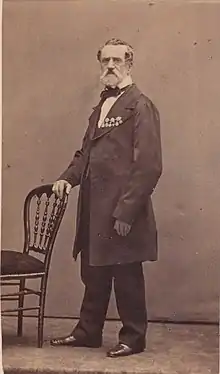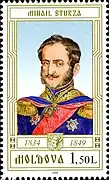| Mihail Sturdza | |
|---|---|
 | |
| Prince of Moldavia | |
| Reign | April 1834 – June 1849 |
| Predecessor | Ioan Sturdza |
| Successor | Grigore Alexandru Ghica |
| Born | 24 April 1794 Iași, Moldavia |
| Died | 8 May 1884 (aged 90) Paris, France |
| Spouse | Elisabeth Rosetti (m.1817 – div.1822) Doamna Smaranda |
| Issue | Dimitrie, Grigore, Mihail, Maria |
| House | Sturdza family |
| Father | Grigore Sturdza |
| Mother | Mariora Callimachi |
| Religion | Orthodox |
Mihail Sturdza (24 April 1794, Iași – 8 May 1884, Paris), sometimes anglicized as Michael Stourdza, was prince ruler of Moldavia from 1834 to 1849. He was cousin of Roxandra Sturdza and Alexandru Sturdza.
Early life
He was born as third child and the only son of Grigore Sturdza, Lord of Cozmești, Grand Logothete (1758-1833) and his wife, Princess Maria Callimachi (1762-1822), daughter of Gregory Callimachi, reigning Prince of Moldavia.

Biography
A man of liberal education, he established in Iași, the Academia Mihăileană, the first University in Romania, a institution of higher education, and the precursor of the University of Iași. He brought scholars from foreign countries to act as teachers, and gave a very powerful stimulus to the educational development of the country.
In 1844 he decreed the emancipation of the Gypsies, which until then had been treated as slaves and owned by the Church or by private landowners; they had been bought and sold in the open market. Mihail also attempted the secularization of monastic establishments, which was carried out by Prince Alexandru Ioan Cuza in 1864, and the utilization of their endowments for national purposes.
Mihail quelled the attempted Moldavian Revolution of 1848 without bloodshed by arresting all the few conspirators and expelling them from the country.
Mihail's first wife was Elena Rosetti. His second wife was Princess Smaragda Vogoride, daughter of Stefan Vogoride, Prince of Samos.
He vacationed with his family annually at Baden in Germany. When his and Vogoride's 16-year-old son was killed in Paris there in 1863, he erected a Greek Orthodox church on Michaelsberg to serve as his crypt.[1]
Gallery
 Commemorative stamp
Commemorative stamp Bust of Mihail Sturdza in Baden-Baden
Bust of Mihail Sturdza in Baden-Baden The Princely Court of Moldavia during the first half of the 19th century
The Princely Court of Moldavia during the first half of the 19th century
See also
Notes
- ↑ Winch (1967), Introducing Germany, p. 75.
References
- This article incorporates text from a publication now in the public domain: Moses Gaster (1911). "Sturdza". In Chisholm, Hugh (ed.). Encyclopædia Britannica (11th ed.). Cambridge University Press.